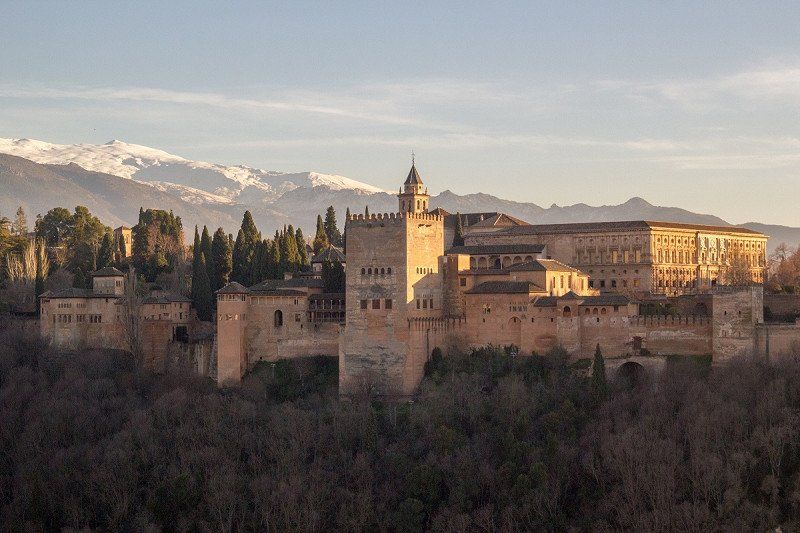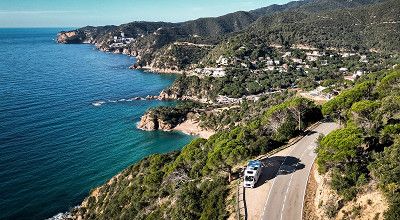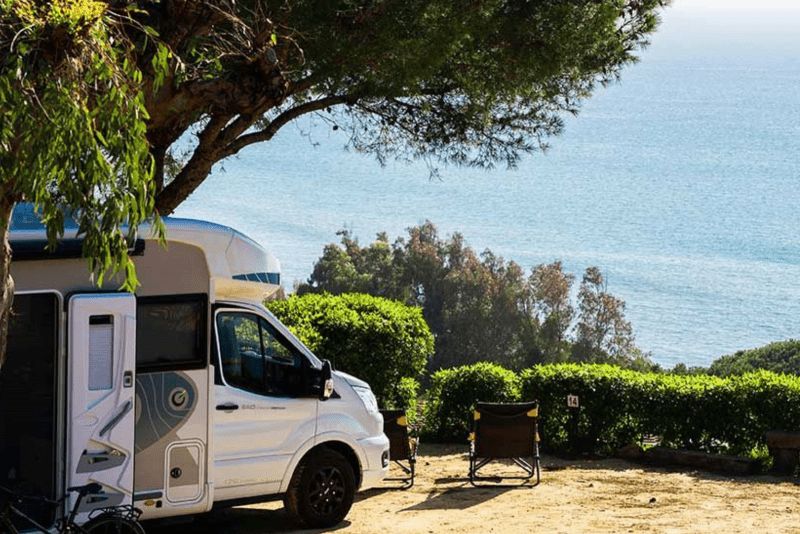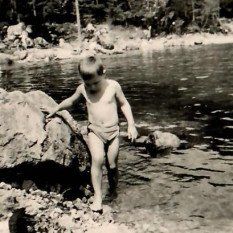Andalusia is one of the most beautiful regions in Spain and has a lot to offer for your motorhome tour. The region is home to passionate flamenco, wild bulls and proud Andalusian horses, breathtaking landscapes, vibrant cities and irresistible tapas. The influences of the Moors can still be felt in the oriental flair of Andalusia.
Thanks to its mild climate, numerous surf spots and the well-developed road network, southern Spain attracts campers all year round. We too are embarking on a virtual and multifaceted tour along the Costa del Sol and the Costa de la Luz:
Stop 1: Granada - a Spanish fairy tale from 1001 nights
Our first stop is the city of Granada, at the foot of the Sierra Nevada. It is famous not only for the globally unique city castle Alhambra, one of the most important examples of Arabic architecture, but also for the ski area in the neighboring mountains. So just pack your skis.
Sitting in a T-shirt in the warm midday sun with a mountain panorama while snow bunnies pass by with snowboards? In Granada this is everyday life in winter. Sierra Nevada means snow-capped mountains. But despite the proximity to the mountains, the climate in the city center is surprisingly mild all year round.

What you shouldn't miss in Granada:
- The world famous Alhambra, of course! Between the magnificent palaces, towers, gardens, water features, columns and courtyards, you feel like you are in a fairy tale from one thousand and one nights. It is not for nothing that the Red Castle is a prime example of Moorish art. Its construction started in the 9th century. Once designed as a fortress with a view over the whole city, it was expanded into a huge palace area under the Nasrid kings Yusuf I and Muhammad V in the 14th century. After the Christian reconquest, the Spanish kings also left their mark, which explains the unique fusion of Arabic and Spanish elements.
- Hang around in the bars of the old town. If you order a drink, you will be surprised with small, free tapas and appetizers almost everywhere.
- Visit El Albaicín, the Moore quarter of Granada and also the oldest one. From here you can enjoy a beautiful view of the Alhambra and immerse yourself in a colorful mix of cultures from the Spanish and Arab world. The Orient is not only to be felt in the markets full of colorful fabrics and Arabic art, but also in the gastronomy. There are numerous so called teterías, which are Arabic tea rooms and oriental restaurants, where you can enjoy what may be the best falafel in the world.
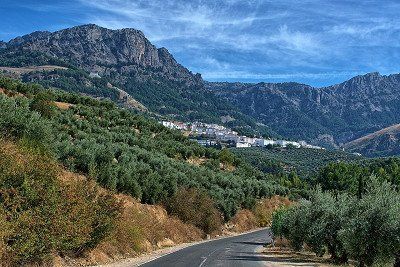
Stop 2: Sierras de Tejeda, Almijara and Alhama nature park
We drive south towards the Costa del Sol, the southeastern stretch of the coast of Andalusia. In summer it is a hotspot for beach holidays, which has washed up a number of huge hotels along the beaches. If you are looking for a real contrast to this classical tourist life, then the so called Sierras de Tejeda - Almijara y Alhama nature park is the right spot for you to visit.
The landscape is characterized by jagged mountain ridges, deep canyons, green valleys and decayed castles of the past. The surrounding area is ideal for experiencing the Andalusian nature while hiking. Nestled in the mountainous landscape are quaint white villages where the clocks tick much slower than in the cities of the region.
The white mountain village Comares is such a small and enchanting place. In the authentic restaurants you get to know the traditional farmer's cuisine of Andalusia. Here the lamb still comes from the neighboring farm and the local country wine rounds off the culinary experience.
In the south of the park you'll find the impressive Nerja Cave. In the 1950s, children from the neighboring village accidentally discovered the ancient stalactite cave while playing. Archaeologists were all the more surprised when they came across prehistoric murals, bones and ceramics. Scientists suspect that the huge cave was used as a dwelling by humans between 30,000 and 1,800 BC. Visiting times for the cave are year round between 9 am and 3.30 pm - except for January 1st and May 15th. In July and August opening hours stretch from 9.30 am to 7 pm.

Stop 3: Mountain village Casares - white beauty
On our way to the south of Andalusia we drive along the beautiful coastal road. A short detour to Casares is definitely worthwhile: It is a small village with bright white houses, whose 15th century castle majestically towers on a mountain a few kilometers from the sea. You can lose yourself in the labyrinthine alleys for hours.
According to legend, Casares owes its name to Julius Caesar. He is said to have discovered the healing springs Baños de la Hedionda near the town. However, the real hero of Casares is Gil Blas Infante. He was born in the white village in 1885 and was considered the father of the Andalusian movement. He is still celebrated today, which is hardly surprising since the residents of Casares never miss an opportunity to celebrate it seems. At the cheerful folk festivals and in the restaurants you will be served typical local stews, goat cheese and tapas with every drink. Enjoy!

Stop 4: Tarifa - surfer's stronghold and southernmost city in Europe
The journey goes on to Tarifa at the southernmost point of the Costa de la Luz and thus also Spain and Europe. The Costa de la Luz and its surroundings are considered to be more rough, but also more untouched and therefore more beautiful than the comparatively touristical Costa del Sol.
Standing along the Strait of Gibraltar on the wide beaches full of dunes and sand, you can see the outline of Africa, which lies only 14 kilometers away in linear distance. With a little luck, dolphins and whales can be spotted in the strait - sightings are common here between the Atlantic and the Mediterranean.
The wind conditions and the rough sea make Tarifa a popular hot spot for kite surfers as well as windsurfers. In the evening there is a lively bustle in the bars and the smell of grilled fish blows through the alleys of the winding old town.
You want to travel further south? The ferry takes you in just 35 minutes over to Tangier in Morocco where you can immerse yourself in a completely different world.
Stop 5: Cadiz - colorful carnival in the oldest city in Europe
Next stop of our motorhome tour is Cadiz, a real highlight on our trip to Andalusia. It is not for nothing that it is called La Habanita, which means the little Havana: its charm is in no way inferior to the original. Therefore, the Havana scenes of the James Bond film "Die Another Day" were filmed not in the Cuban capital but in Cadiz in 2002.

The city is full of history. The Phoenicians, once an influential seafaring people, founded Cadiz as early as 1,100 BC. This makes Cadiz the oldest city in Europe. The city, which was then called Gadir, was an important trading base with a strategic location. The Carthaginians, Romans, Visigoths and Moors later shaped the city. According to tradition, none other than Christopher Columbus started his trip to America from Cadiz. Spain's first written constitution was also published here in 1812. Today, a memorial commemorates this historic event.
Cadiz is also known for its famous carnival. It actually competes with the big carnival in Cologne, Germany. During the carnival season in February, all of Cadiz turns into one huge street festival. People travel from all over Spain and Europe to experience the shrill spectacle.

What you shouldn't miss in Cadiz:
- Stroll through the old town! It is surrounded by a fortress wall on a small peninsula that can be reached on foot via a narrow promontory. You can walk around the old town along the sea shore.
- Walk up to the cathedral in the old town. The baroque wonder with neoclassical elements is the largest building in the city. From up here you have a great view and can admire the golden dome of the church tower up close.
- If you want to squeeze in a bit of outdoor live, take a hike in the landscape in the nearby Bahía de Cádiz nature park.
- Eat fresh fish in the La Viña district.
- Watch the flamenco dancers in the Taberna Flamenca La Cava.

Stop 6: Seville - cradle of flamenco, tempting tapas & unique architecture
Seville, the largest city in Andalusia, is undoubtedly one of the most beautiful places in Spain. Authentic tapas are served in the numerous bars and flamenco spectacles are on the agenda here. Colorful mosaics and tiles adorn the cityscape everywhere.
Seville has interesting museums, magnificent royal palaces, picturesque squares and gardens. The Andalusian capital is also very bike-friendly. The best way to get to know Seville is to take an extended tour on city bikes that you can rent in case you do not have your on bicycle with you.
What you shouldn't miss in Seville:
- The Flamenco Museum, where you can admire flamenco spectacles in addition to the exciting history of dance.
- The pompous royal palace Alcázar, which illuminates the golden past of Seville.
- The royal tobacco factory Real Fábrica de Tabacos, where today lectures are given by the University of Seville. In the 18th century thousands of women worked in this factory - amongst them a lady called Carmen, whose story became worldfamous through the opera Carmen.
- Try out the huge range of tapas! There are numerous traditional tapas bars around the Alameda de Hercules square, in Calle Betis in the Triana district and in Calle Pérez Galdós in the Alfalfa district.
- Also try the local specialties Secreto Ibérico (fillet of Iberico pork), Carrillada de cerdo (pork cheek) or, vegetarian: Espinacas con Garbanzos (spinach with chickpeas). A classical sweet dish is of course the tasty, deep-fried pastry Churros con Chocolate.
- Stroll through the former Jewish quarter Barrio Santa Cruz with its traditional handicraft shops, which is one of the most beautiful in the old town.

Stop 7: Córdoba - seas of flowers and the famous Mezquita
Let's get to the last stop on our tour of fascinating Andalusia: Cordoba. The city in the north of Andalusia stands for the most beautiful courtyards in all of Spain and the Mezquita - a unique mixture of a cathedral and a mosque.
Córdoba's traditional old town can be conquered on foot. Don't miss out on looking into an inner courtyard here and there: the so-called patios are decorated with colorful flowers by the residents, because everyone wants to win the next competition for the most beautiful inner courtyard, which takes place every year in May.
What you shouldn't miss in Córdoba:
- A visit to the gigantic Mezquita with its impressive columns, colorful tiles and beautiful gardens
- Eating in the food court Los Patios de la Marquesa in the former Jewish quarter Judería. There is a huge culinary selection starting with typical dishes from the Cordoba region and going on to the Arabic cuisine.
- Local specialties include Salmorejo (cold, viscous soup made from tomatoes, garlic, bread crumbs, olive oil, vinegar and salt), Flamenquín (breaded pork wrapped with Serrano ham), Rabo de toro (oxtail) and Berenjenas con miel (fried eggplants with honey).
- It is said that the best Spanish olive oils come from the Cordoba region. Taste different oils in the shops in the old town and don't forget to buy some to have it with you in your motorhome or caravan.
Camping in Andalusia
The region Andalusia has numerous campsites. Not all of them are open during the winter months but you can easily filter them by date in our Freeontour campsite guide!


